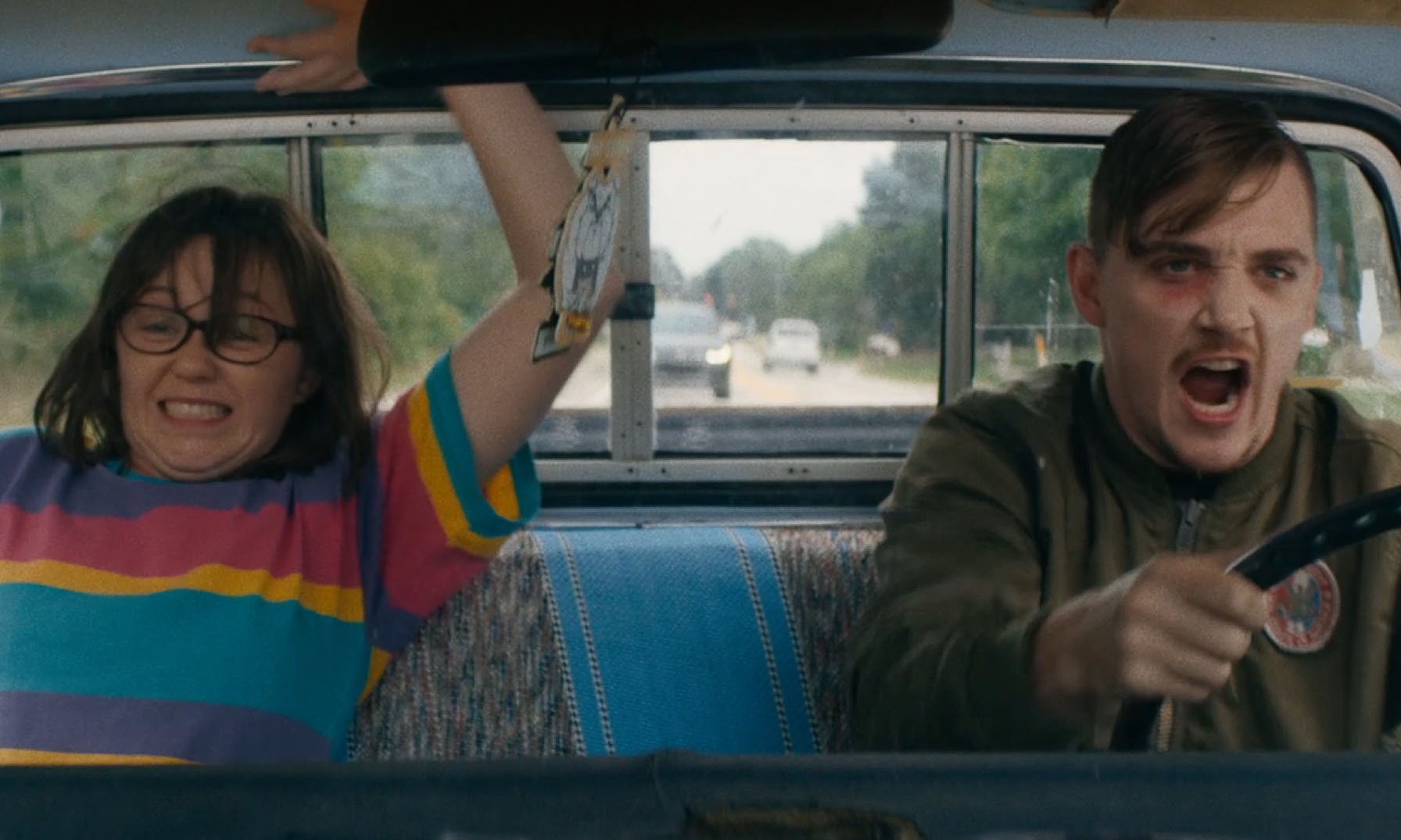The world has changed considerably since “Dinner in America” first premiered at Sundance 2020, but the underlying anger that drives Adam Rehmeier’s subversive romantic comedy now seems like a prophecy as Americans emerge from the turbulence of a pandemic and waves of social unrest filled with rage rather than relief. Certainly there were some were immediately delighted with the film in pre-COVID times, exploding like a hand grenade on unsuspecting viewers in Park City as it first follows Simon (Kyle Gallner) and Beth (Hannah Marks) after they’re released early from a juvenile detention center — not for good behavior, but because the prison is overcrowded — only to find themselves in another form of incarceration at her parents’ Thanksgiving spread, where the kerosene sitting in their garage is less combustible than the conversation at the dinner table where racial slurs are thrown around like confetti and Simon is eyed with suspicion by Beth’s father Bill (Nick Chinlund) and infatuation by her mom (Lea Thompson).
When no one else is willing to own up to their unhappiness, Simon stands out and finds a use for the kerosene to eventually make a fiery exit, setting him on the path to meet Patty (Emily Skeggs), an endlessly teased junior college dropout who writes passionate letters to the lead singer of her favorite punk band but has no relationships in her life, including her own family, where love runs both ways. Rehmeier hardly foregrounds the film’s setting, but it lingers around the edges where Patty is laid off from her pet store job with her boss using a rise in Michigan’s minimum wage as an excuse and an unwillingness of nearly everyone to engage in anything but the most banal of small talk suggest a society in decline, yet the genuine connection between Patty and Simon gives reason for hope, bonding at first when the latter needs to find a place to hide from the cops and eventually coming to discover they share a love of punk music where suddenly the raw and authentic emotions that most suppress but they cannot are appreciated.
For a satire that needs to be pitch perfect in all regards to work, Rehmeier found the perfect pair in Gallner and Skeggs, a Tony nominee for the Broadway adoption of Alison Bechdel’s memoir “Fun Home,” who bring a sweetness to their sour situation and have the chops to pull off both the film’s dramatic as well as musical demands. Making Patty and Simon appear as an odd couple to everyone but one another, the actors clearly work off a trust between each other that makes their bond onscreen especially strong and with the long-awaited arrival of “Dinner in America” in its country of origin after building a head of steam elsewhere around the world, Gallner and Skeggs spoke about how they tapped into their rebellious side and ultimately leaned on each other to create such an unexpectedly lovely duet.
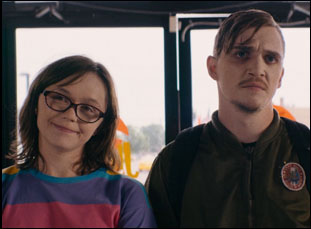
Kyle Gallner: It’s funny. I read for another movie and one of the producers on “Dinner in America” was making that movie that I did not get, but he liked me and thought I could be really good for “Dinner in America” and I was off filming a TV show at the time and I had new babies, so I started to read the script, got a couple pages in and never got back to it. But a couple years later, I was on another movie [with “Dinner in America”‘s director of photography], Jean-Philippe [Bernier] and “Dinner in America” had fallen apart and he told me, “You’d be really good for this movie that was supposed to go.” It sounded really familiar, so I looked in my e-mail and sure enough, I still had [the script] from years ago and I read it and I fell in love with it. I fell in love with Simon and Patty and their relationship and the world that Adam had created, so I got my reps to ask if they could set up a Zoom with Adam, hoping that he’d still want to talk to me all these years later and not want to tell me to go to hell. [laughs] He did and we talked for three hours and we digitally high-fived and we were off to the races a couple months later.
Emily, knowing all that you could do as a performer from “Fun Home,” it doesn’t seem like parts like this come around too much. Was it an exciting prospect?
Emily Skeggs: Yeah, definitely. It’s not often you get these roles that are so unique and fleshed out and allow you to push the envelope. Kyle and I laugh all the time because we’re usually playing the weirdo best friend who pops in. This movie and “Fun Home” were really specific and really rare opportunities for me to really delve into characters that are really complicated and thus really real. When I got the script, I was like, “How am I going to do this?” Which was the question I have with every script, but this one in particular, [I thought] “This is wild. How are we going to personalize these characters and make them that people that audience members can relate to?” A lot of our question while making “Fun Home” was always, how are we going to get people to see into the story and really, really relate to it because it’s so specific? And while they’re two really different projects, they really informed who I am as an actor and how I process characters and prepare. [These] are pinnacles of my career, working with just the best people who really have the art in mind and really are dedicated, so I just feel very lucky and blessed and so grateful to work with Adam and Kyle. Now I want to make everything with them.
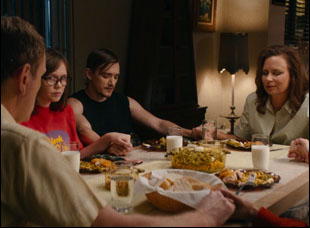
Kyle Gallner: It was like trial by fire. We really got thrown right into it. There was the prep work you do before you get there and a couple conversations with Adam and I had my ideas about how I wanted to move and talk. Then you get to set and you start putting the wardrobe on and that starts to inform some things and then you get the haircut and that starts informing some things and then you can build the character from there. But the day after we got there, we went straight into the recording studio, doing the punk music. Emily and Adam wrote the “Watermelon” song, and then me and Emily spent a lot of time together. We’d go to the grocery store and grab some dinner and cook and hang out, really just to get to know each other.
By the time we got to set me and Emily really built a relationship and a trust with each other that only grew, so whatever insecurities I had or questions I had [during filming], I would pull her aside and say, “What the fuck am I doing?” And she’d just say, “Relax! Relax!” [laughs] We just built this bond and a lot of that comes from that two weeks because sometimes you get there and two days later, you’re shooting a scene and [or] the end of the movie and you haven’t even gone on this journey with each other and that can be hard. As time goes by, I’m realizing how crucial that two weeks truly was, especially for a movie like this because you ride this razor thin line [in this film] of it being too much, so that time was invaluable.
Emily Skeggs: Yeah, it really gave us the time to figure out what the limits and boundaries of what these characters were and build a really strong trust. I think every project should do this. Coming from theater, I’m like, why don’t we all get to know each other a little bit before we start doing this?
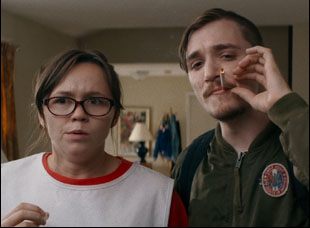
Emily Skeggs: Yeah, I still think about that and I don’t quite know how we did that. Adam had asked me in the process of auditioning if I would be interested in writing the song with him and that would be a part of the process. Coming from the theater world, I had always just sung other people’s songs. I had never really written a song before, so I was really nervous, but I’m also a writer, so I brought in stream-of-consciousness Patty poetry and Adam and I wrote it in a day with Kyle sitting there in this dark room in this abandoned office building in Detroit. [laughs] It came really easily and it was a really liberating experience for me. I love the song and it really helped me shape Patty’s tempo, the way Patty thinks and also how weird Patty is willing to go. I think if I hadn’t written the song during the process, she would be totally different, so I really cherish that memory.
Kyle Gallner: Me too. I loved it. It was such a trippy thing. It was the first look into Patty’s psyche of like, “What the hell is going on in there? That is crazy.” [laughs] But I also just want to give a shout out to Adam because I know people get nervous with music and I know he [was] pressed with people being like, “What’s the song? We need the song. Write the song.” And he’s like, “Nope! I’m going to write it with my actor when they show up and that’s what it’s going to be.” He stuck to his guns and the beauty of that song is all these people come in and see it as an opportunity to showboat or to be this big thing and there’s such a beauty in the wonderful simplicity of this song. When Simon’s looking at [Patty] and he goes [approvingly], “Man, that really was tits,” it’s really this moment of “I see you. I truly see you” and it’s such a great moment whereas if somebody tried to make it into this thing, it would’ve been more like, “Oh, I see a singer.”
Emily Skeggs: I think when I realized how pure Adam wanted my vocal quality to be, I realized how pure he wanted Patty to be and how open Patty really needed to be in order for this union to happen.
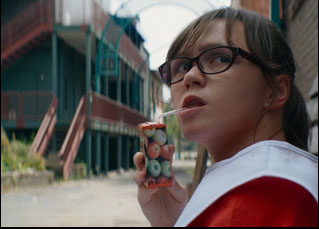
Kyle Gallner: Adam did a nice job. Sometimes you get on some projects and somebody has something on their mind so much it’s almost like oppressively so, like, “No, you have to stand here and you have to…” There’s a really nice combination of Adam really knowing what he wanted and how he wanted it to feel and he worked very closely with [the cinematographer] JP and they really created this world, but when we got there, pretty much everything made sense. It is a little difficult sometimes to have to do things to camera or you’re looking at a piece of tape and you can’t see the actor, but as the movie went on and you really start to see the dance of “Oh, this is what we’re making, this is how this looks, this is why we’re doing that,” you start to get with it.
It was a little jarring [at first]. Our first day was that scene where [Patty and Simon] meet in the alley and we’re doing it down the barrel and I’m like, “What are we doing?” And Adam would tell you, he did it on purpose. He wanted to shake us up a bit. He wanted to prep us for what was to come and it was smart. After that, I felt okay. But because I was still figuring out who Simon was, I was already in this insecure state and that motherfucker [Adam]…he got me. I’ll give it to him. He got me pretty good.
Emily Skeggs: But by the time we shot the [more emotionally taxing] shots down the barrel, like when I was singing to you, we were having such a great time making the movie and falling in love with these characters and so excited to share it with the world, we were like, “No, no, we need to show them who these people are” and the only way to do it is by direct vulnerability.
Kyle Gallner: Yeah, because as an actor, it’s like always rule number one, “Don’t look here.” “But you’re telling me to look here.” It goes against everything you’re used to.
This has taken an unusual path back to America after playing Sundance in 2020 where it’s accrued a global following first before coming here. What’s it been like to see the reaction?
Emily Skeggs: It’s built a lot of anticipation and it has a lot of fans all over the place who are real hardcore lovers of this film. There’s a lot of fan art coming out and people are covering the “Watermelon” song…
Kyle Gallner: Dolls…
Emily Skeggs: It’s cool that it mirrors the tone of the film that it’s had such a punk release. It’s gained this punk cult following, which I think is awesome and I’m just so excited for more people to see it. It feels like it’s time.
“Dinner in America” opens in select theaters on May 27th, including the Drafthouse Los Angeles and the Drafthouse Manhattan, and will be available on digital on June 7th.




